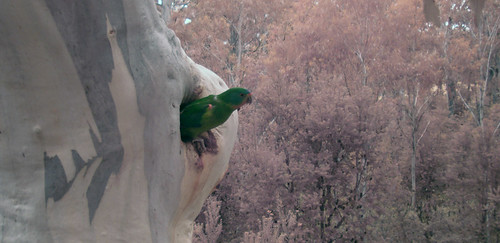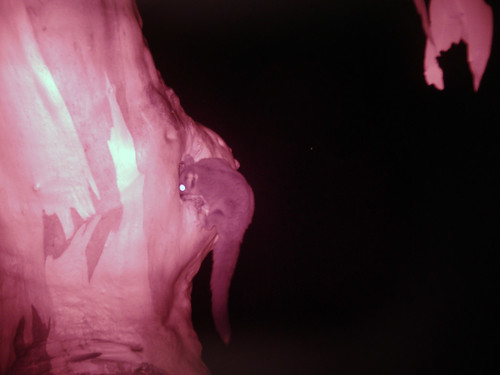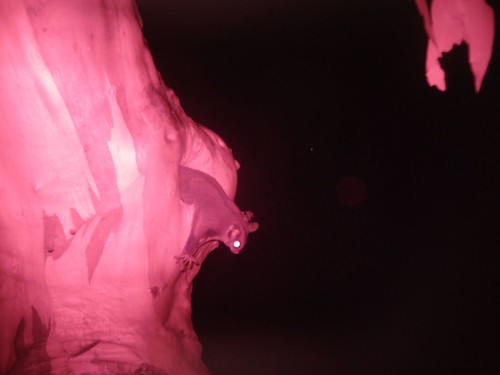Sugar gliders are eating swift parrots – but what’s to blame?
 Monday, May 5, 2014 at 23:50
Monday, May 5, 2014 at 23:50  Caught: a female swift parrot emerging from her tree-hollow nest. Image by: Dejan StojanovicSwift parrots are one of Australia’s most endangered birds, but until very recently we didn’t know why. New research shows that they’re being eaten by sugar gliders at their breeding grounds in Tasmania, but even that’s not the full story.
Caught: a female swift parrot emerging from her tree-hollow nest. Image by: Dejan StojanovicSwift parrots are one of Australia’s most endangered birds, but until very recently we didn’t know why. New research shows that they’re being eaten by sugar gliders at their breeding grounds in Tasmania, but even that’s not the full story.
Conservationists have known for decades that swift parrots are in trouble. Across southeastern Australia, the forests and woodlands where swift parrots live have been converted to farmland, swallowed by urban sprawl and been chipped away by logging.
These processes are well known to drive the decline of forest wildlife, but until recently, we didn’t fully understand the subtler effects of deforestation on swift parrots.
A difficult bird to study
Swift parrots are difficult to study. Although they migrate from the Australian mainland to Tasmania to breed each spring, swift parrots rarely reuse the same nesting area in successive years. Each year the parrots move to a new location to breed depending on where food (nectar from flowering eucalyptus trees) is most abundant. They use hollows high in trees as nests, and these hollows are most abundant in old growth forests.
Finding nests for research demands an intensive annual search across the east coast forests of Tasmania, and once found, the trees have to be climbed to monitor breeding success. However, this intensive research effort has resulted in the revelation of new and astonishing impacts of forest loss on the breeding biology of swift parrots.
Surprises caught on camera
Using motion activated camera traps deployed high in trees to monitor swift parrot nests, we recorded unexpectedly high rates of parrot deaths. The cameras revealed that sugar gliders visit the nests of swift parrots at night where they kill and eat the adult bird and her eggs.
 A sugar glider entering a swift parrot nest. Image by: Dejan StojanovicAlthough sugar gliders are widespread across the Tasmanian mainland, there is good evidence to indicate that they were introduced there early last century. Sugar gliders are typically considered primarily nectar/insect feeders, but our data reveal that they are an opportunistic but important bird predator.
A sugar glider entering a swift parrot nest. Image by: Dejan StojanovicAlthough sugar gliders are widespread across the Tasmanian mainland, there is good evidence to indicate that they were introduced there early last century. Sugar gliders are typically considered primarily nectar/insect feeders, but our data reveal that they are an opportunistic but important bird predator.
Cameras revealed that sugar glider predation results in an abysmal survival rates for swift parrot nests. Only 17% of swift parrot nests were successful on mainland Tasmania, and we found that although many predators attempted to prey on parrot nests, only sugar gliders were successful. Over 80% of sugar glider predation events resulted in the death of the adult female parrot in addition to her eggs, and sugar gliders have been recorded at all of the regions where swift parrots breed on mainland Tasmania.
 .....and leaving. Image by: Dejan StojanovicInterestingly though, sugar glider predation pressure is not the same at all regions across Tasmania where swift parrots breed. For instance, sugar gliders are absent from Tasmania’s offshore islands, and island breeding swift parrots rear 100% of their nests successfully.
.....and leaving. Image by: Dejan StojanovicInterestingly though, sugar glider predation pressure is not the same at all regions across Tasmania where swift parrots breed. For instance, sugar gliders are absent from Tasmania’s offshore islands, and island breeding swift parrots rear 100% of their nests successfully.
Deforestation ultimately responsible
But it turns out sugar glider predation may be a symptom of a deeper problem. On the Tasmanian mainland, where sugar gliders can be found at all swift parrot breeding grounds, we found a link between glider predation and forest cover. Where there was less logging, mature forest cover was higher and there was less predation from gliders.
In contrast, at regions where mature forest cover had been reduced (by agriculture, logging, urban development, wildfire etc), swift parrot nests suffered predation rates as high as 100%. These data point to a more complex relationship between forest loss and breeding success for swift parrots than previously supposed. Urgent research is needed to tease out the interactions between swift parrots, sugar gliders and the availability of mature forest (and the tree hollows such forests support), particularly given that deforestation is still ongoing.
 A pair of swift parrots at a nest. Image by: Dejan StojanovicSaving swift parrots needs a rethink
A pair of swift parrots at a nest. Image by: Dejan StojanovicSaving swift parrots needs a rethink
For the last 20 years, concerns about swift parrot conservation have focused on the loss of habitat on the Australian mainland, where the birds migrate for winter. Although loss of Tasmanian forests is known to be a threat, lack of detailed information about breeding success concealed the complex relationship between forest loss and predators.
Discovering this relationship has highlighted the urgent need to consider new approaches for managing swift parrots. Presently, conservation management of swift parrots focuses on retaining patches of potential habitat, but typically these patches are surrounded by highly disturbed forest.
Our research suggests that sugar glider predation is worse when total forest cover near swift parrot nests is low.
This has major implications for current approaches to managing human impacts on the forests where swift parrots breed. There is an urgent need for longer-term data to understand how landscape scale forest loss impacts sugar gliders, and what conditions swift parrots need to survive.

